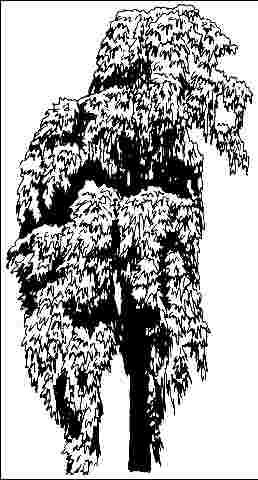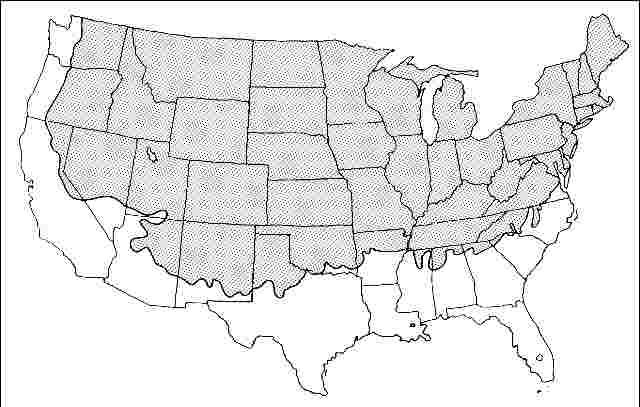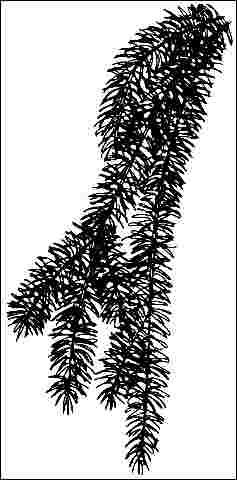Introduction
If left unpruned and untrained, this weeping, bush form of Norway Spruce only reaches a height of one-and-one-half feet but spreads widely across the ground, often reaching a width of 10 feet or more, making it quite spectacular for drooping over raised planters or retaining walls. However, when staked to form an upright trunk, the densely-foliated branches sweep downward with branch tips pointing out and up, and the entire plant forms an irregular, upright, weeping silhouette. Quite spectacular but lots of work is required to get the plant to make a tree. This is an exquisite plant which can undeniably `make' an entire landscape.

General Information
Scientific name: Picea abies
Pronunciation: PIE-see-uh AY-beez
Common name(s): 'Inversa' Norway Spruce
Family: Pinaceae
USDA hardiness zones: 2B through 7A (Fig. 2)
Origin: not native to North America
Invasive potential: little invasive potential
Uses: Bonsai; specimen; screen
Availability: somewhat available, may have to go out of the region to find the tree

Description
Height: 30 to 40 feet
Spread: 10 to 15 feet
Crown uniformity: symmetrical
Crown shape: weeping
Crown density: moderate
Growth rate: slow
Texture: fine
Foliage
Leaf arrangement: alternate (Fig. 3)
Leaf type: simple
Leaf margin: entire
Leaf shape: needle-like (filiform)
Leaf venation: parallel
Leaf type and persistence: evergreen, needled evergreen
Leaf blade length: less than 2 inches
Leaf color: green
Fall color: no color change
Fall characteristic: not showy

Flower
Flower color: pink
Flower characteristics: not showy
Fruit
Fruit shape: oval, elongated, cone
Fruit length: 3 to 6 inches
Fruit covering: dry or hard
Fruit color: brown
Fruit characteristics: does not attract wildlife; showy; fruit/leaves not a litter problem
Trunk and Branches
Trunk/bark/branches: branches droop; not showy; typically one trunk; thorns
Pruning requirement: needed for strong structure
Breakage: resistant
Current year twig color: brown
Current year twig thickness: medium
Wood specific gravity: unknown
Culture
Light requirement: full sun
Soil tolerances: sand; loam; clay; acidic; slightly alkaline; well-drained; occasionally wet
Drought tolerance: moderate
Aerosol salt tolerance: unknown
Other
Roots: not a problem
Winter interest: no
Outstanding tree: no
Ozone sensitivity: unknown
Verticillium wilt susceptibility: resistant
Pest resistance: sensitive to pests/diseases
Use and Management
`Inversa' Norway Spruce tolerates most acid soils if moist and transplants easily if balled and burlapped or potted. Many small-diameter roots originate from the base of the trunk and they are often found fairly close to the surface of the soil. This allows them to tolerate wet soil fairly well although trees do fine with no irrigation, even in clay. The root system is very dense and other plants often grow poorly beneath the canopy.
Pests
Mites, aphids and bagworms are the most common pests.
Mites are the worst problem, and in hot weather they can build to populations which require control. They can be a major problem in summer after hot dry weather, especially near concrete, buildings, and other urban surfaces which reflect heat. The small insects can't be readily seen with the naked eye. The first noticeable symptoms are yellowing at the base of the oldest needles on infested branches. Close inspection with a magnifying glass will confirm the presence of the mites.
Two gall commonly attack Spruce. Eastern Spruce gall adelgid forms pineapple like galls at the base of twigs. Galls caused by Cooley's Spruce gall adelgid look like miniature cones at the branch tips. The gall adelgids do not kill trees unless the infestation is heavy. A few galls on a large tree are not serious.
Bagworms make a sack by webbing needles and debris together. Small numbers may be picked off by hand or use Bacillus thuringiensis .
Spruce budworm larvae feed on developing buds and young needles. The yellowish brown caterpillars are difficult to see.
The Spruce needle miner makes a small hole in the base of a needle then mines out the center. Dead needles are webbed together and can be found on infested twigs.
Pine needle scale is a white, elongated scale found feeding on the needles only. Populations would have to be quite high to cause major damage.
Sawfly larvae may feed on the needles. One infestation will usually not kill the tree.
Diseases
Cytospora canker infects a branch then eventually kills it. The lower branches are usually attacked first then progressively higher branches. The needles turn brown to reddish brown and eventually drop off. White resin patches are seen on infected branches. Prune off infected branches. Be certain to water Spruces during dry weather. Blue Spruce is particularly susceptible.
Spruce may be attacked by needle casts. One causes needles to turn yellow or brown and drop off. Another, affects the lowest needles first then moves up the tree. Infected needles are a mottled yellow.
Several rust diseases attack Spruce but these are rarely seen. Infected needles turn yellow and drop off.
